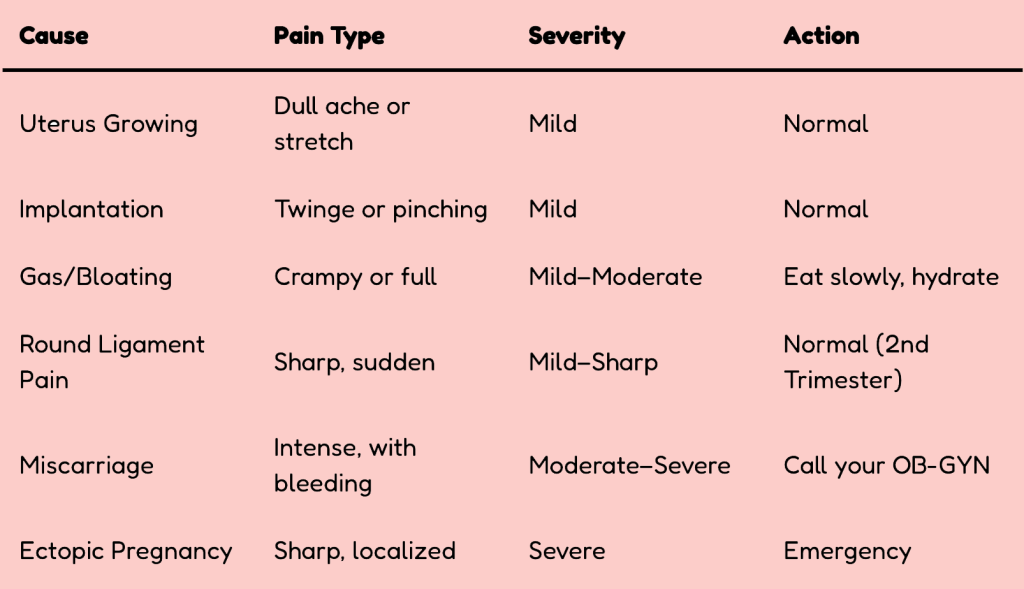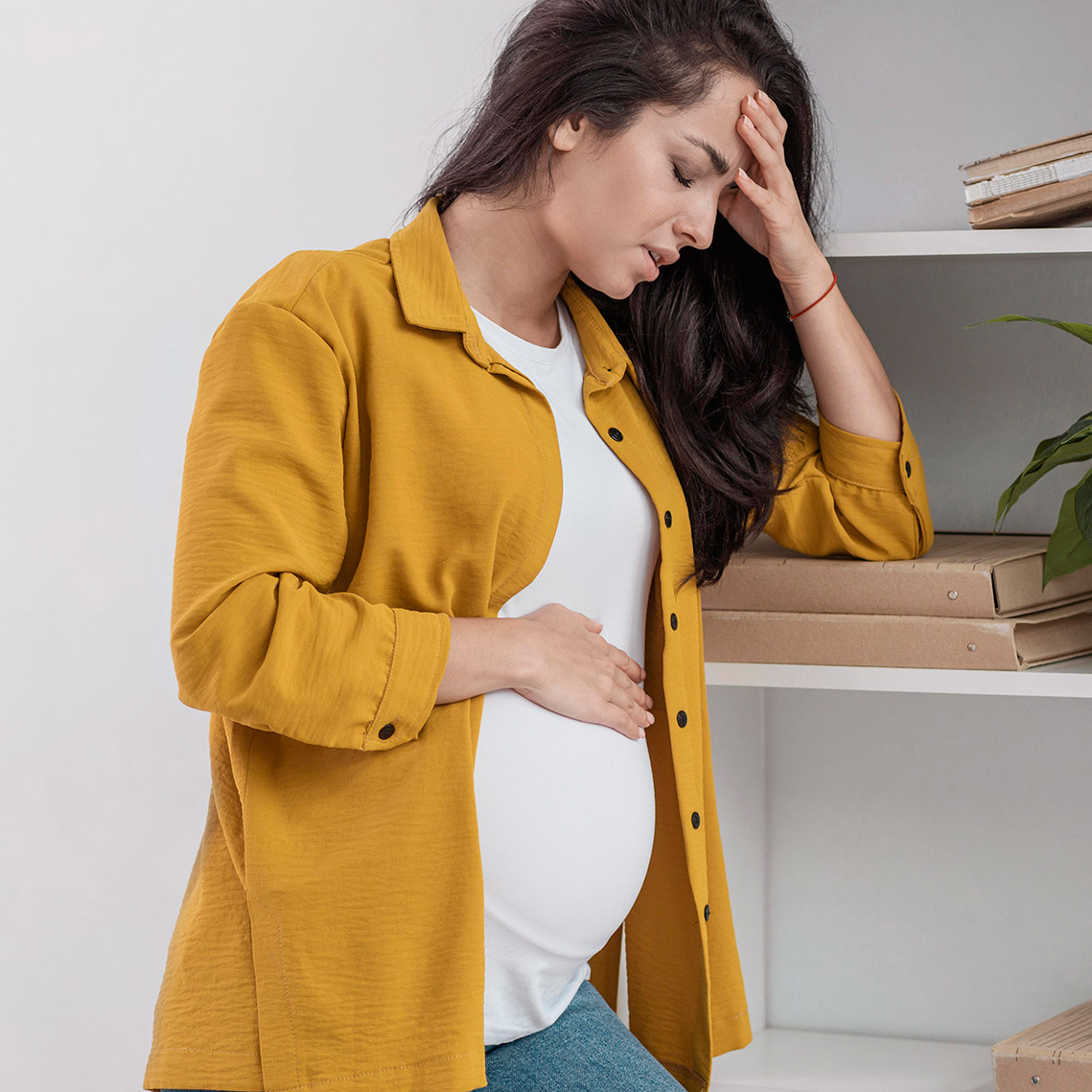Pregnancy is filled with changes—some exciting, others a bit worrisome. One of the most common early pregnancy symptoms is cramping, which can feel similar to menstrual pain. But how can you tell if it’s normal pregnancy cramping or something that needs medical attention?
This guide covers everything you need to know: causes of pregnancy cramps, when to worry, how to relieve pain, and what trusted sources say about this early symptom.
📖 Related: 6 Weeks Pregnant: What to Expect, Cramping & First Ultrasound Guide
🤰 Is Cramping Normal in Pregnancy?
Yes, mild cramping during pregnancy—especially in the first trimester—is often completely normal. It usually results from the uterus expanding, hormonal shifts, and increased blood flow to the pelvic area.
According to ACOG, uterine cramping is a common, harmless part of early pregnancy as the body adjusts to the growing embryo.
🧠 Why Does Cramping Happen During Pregnancy?
Cramping can stem from various causes, most of which are not dangerous:
1. Implantation Cramping
Occurs around 6–12 days after ovulation when the fertilized egg attaches to the uterine wall. This may cause mild spotting and twinges in the lower abdomen.
2. Uterus Expansion
As the uterus begins to grow (especially by weeks 6–8), you may feel a stretching or pulling sensation in the lower abdomen.
3. Digestive System Changes
Hormones like progesterone slow digestion, often leading to gas, bloating, and mild cramps.
4. Round Ligament Pain
In the second trimester, the round ligaments supporting the uterus stretch and may cause sharp, stabbing pain when you move suddenly.
💬 Related Reading: 7 Weeks Pregnant – Symptoms, Belly Changes & Tips
🚨 When Pregnancy Cramping Might Be a Concern
While most cramps are harmless, some situations require immediate medical attention.
🚩 Worrisome Signs Include:
- Severe or persistent abdominal pain
- Heavy bleeding or clotting
- Fever over 38°C (100.4°F)
- Pain localized to one side of the abdomen
- Shoulder pain (possible sign of internal bleeding)
🛑 Possible Serious Conditions
1. Ectopic Pregnancy
Occurs when the embryo implants outside the uterus, often in the fallopian tube. Symptoms include:
- Sharp one-sided pain
- Shoulder pain
- Dizziness or fainting
- Vaginal bleeding
Source: NHS – Ectopic Pregnancy
2. Miscarriage
Cramping accompanied by heavy bleeding and lower back pain may indicate a miscarriage.
According to the Mayo Clinic, up to 20% of known pregnancies end in miscarriage, most occurring in the first trimester.
📋 Early Pregnancy Cramping: Quick Comparison Chart

🧘 How to Relieve Pregnancy Cramps Safely
✅ Safe Remedies for Mild Pregnancy Cramps
- Hydration
Dehydration can trigger cramping. Aim for 8–10 glasses of water daily. - Warm Compress or Bath
A warm (not hot) bath can relax your muscles and ease pain. Avoid direct heat on the belly for long periods. - Gentle Movement
Stretching or walking can improve circulation and ease digestive cramping. - Prenatal Yoga or Meditation
These help reduce tension and improve overall well-being. - High-Fiber Diet
Prevent constipation, a common cramp trigger, by eating more whole grains, fruits, and vegetables.
🔗 See Also: First Trimester Checklist: What You Should Do Now
📞 When to Call a Doctor About Pregnancy Cramping
Call your healthcare provider if you experience:
- Pain that worsens or persists more than a few hours
- Bleeding heavier than spotting
- Fainting or severe dizziness
- Cramping accompanied by fever or chills
- History of ectopic pregnancy or miscarriage
It’s always better to over-report than under-report during pregnancy.
🤝 According to the World Health Organization (WHO), timely prenatal care is critical to prevent maternal complications.
🔍 Frequently Asked Questions (FAQs)
Yes, light cramping due to implantation or uterine growth is normal in the first trimester.
They are often stronger than period cramps and may radiate to the lower back or pelvis, often with bleeding.
Absolutely. Lack of water can cause uterine muscles to contract. Drink plenty of fluids daily.
Sharp pains like round ligament pain are normal later in the first or second trimester. But localized, one-sided sharp pain should be evaluated by a doctor.
🔗 Related Internal Articles
- 6 Weeks Pregnant: What to Expect, Cramping & First Ultrasound Guide
- 7 Weeks Pregnant – Symptoms, Belly Changes & Tips
- First Trimester Checklist: What You Should Do Now
✍️ Final Thoughts: Trust Your Body — And Your Doctor
While pregnancy cramping can feel alarming, most cases are a normal part of the process. Still, it’s essential to listen to your body, stay informed, and seek medical guidance when in doubt.
Early education, proper hydration, a nutrient-rich diet, and open communication with your healthcare provider are the keys to navigating this journey safely.

Hello, everything is going well here and ofcourse every one is sharing information, that’s actually fine, keep up writing.
Thank you so much for your kindness comment